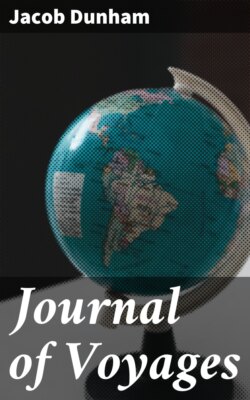Читать книгу Journal of Voyages - Jacob Dunham - Страница 5
На сайте Литреса книга снята с продажи.
CHAPTER III.
Sloop Biddle.
ОглавлениеTable of Contents
Soon after my unfortunate adventure in the New-York, I took command of a schooner called the Caty Ann, and made a voyage to Savannah and back to New-York, without capture. Although Sir James Yeo, in the South Hampton frigate, was closely blockading Savannah at the time, I made a second attempt to proceed to the same port. After sailing a few miles south of Sandy Hook light-house we were chased back by an English frigate, and the schooner narrowly escaped being captured. The whole coast was so closely blockaded that I abandoned going to sea again until after peace was proclaimed.
About the first of May, 1813, I took charge of the brig Cyrus, of New-York, and made one voyage to Georgetown, South Carolina, and back, and then made another to Bermuda and Turk's Island.
Ever ready to sacrifice my personal comfort for the prospect of increasing the means of gaining an honest living—being in the prime of life and enjoying good health, and that huge monster, Fear, seldom throwing his dark shadow across my path—I engaged again to open a trade with the Indians on the Musquito Shore, on the borders of South America, now called New Greneda, or Central America. This country formerly belonged to the government of Spain, which still tried to exercise authority over it, although rebellions had broken out both in the North and South of it; and, the then called government of Columbia, under General Bolivar, aided by a number of Americans and others, with vessels commissioned as privateers, and land forces, made a strong resistance to the Spanish government. They fought many desperate battles with the royalists, under what was then called the Patriot, or Columbian flag. Carthagena, their largest sea-port, was taken and re-taken three several times, and every man in it put to death.
The king of the Musquito Indians claims the sea-coast of that country from the False Cape, lat. 15° 14' N. to Port Boro Toro, lat. 9° 29' N. The government of Old Spain likewise claimed it, but never had been able to dispossess the Indians. The sea-board of this country is very level, interspersed with lakes, rivers and creeks. From May until November the country is visited with heavy showers of rain. In many places I have from time to time walked in water some inches deep to go from one house to another. The Indian towns are mostly built some distance up the rivers or creeks, to secure them from any attacks from the sea-board. They have no roads inland, their whole travel being in canoes, by which means they can visit the different tribes, hauling them across narrow necks of land that separate one lake or river from another.
The Spanish government, under an old blockading decree had declared that any person found trading with these Indians, if captured, should lose his cargo by confiscation, and be sent to the mines for life. The government of Spain likewise claimed three small islands near the Musquito Shore, viz: Old Providence, lying in lat. 13° 27' N. long. 80° 39' W. This island I found inhabited by about thirty families of free people of different nations and colors, and from five to thirty slaves to every free person in the island. St. Andreas, lying in lat. 12° 33' N. long. 81° W. It contains about seventy-five families of free people, and about eight hundred slaves; it was lately the residence of a Spanish Governor named Gonzales. This place had a small fort, garrisoned with about thirty soldiers. I shall hereafter give the reader a further description of the island, related to me by Captain Mitchell, commonly called Mitchell the Pirate.[A] Great Corn Island lays in lat. 12° 19' N. long. 82° 11' W. about forty miles from the main land. Little Corn Island, lying about ten miles from the great one, is inhabited, and produces large quantities of cocoa nuts and wild fruits.
